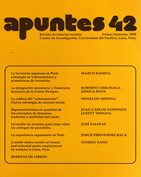Quechua representations of the concepts of rest, fallow and soil fertility.
DOI:
https://doi.org/10.21678/apuntes.42.470Keywords:
Peru, quechua language, soil fertility, fallowing, linguisticsAbstract
In his linguistic and socio-cultural activity, the human being attempts to make sense of his relationship with the world at large. His representation of the world is linked to his language in two ways: nor only instrumental by conditioning the way we think, but also by creating some of our conceptual organizational outlines of the Universe.
We have analyzed texts from Colonial Quechua authors, in addition to contemporary testimonies concerning the fertility of the soil. The connotations and figures of speech employed in the representation of the concepts of rest, fallow and soil fertility presume a reciprocal relationship between the soil and the environment, which are considered as living beings. In this way, agricultural activities -their space, time and social interactions- are not always organized in a manner that is understandable in terms of modern development.
Downloads
Downloads
Published
How to Cite
Issue
Section
License
Apuntes publishes all its articles and reviews under a Creative Commons Attribution (CC BY 4.0) license with the objective of promoting academic exchange worldwide. Therefore, articles and book reviews can be distributed, edited, amended, etc., as the author sees fit. The only condition is that the name of the author(s) and Apuntes. Revista de Ciencias Sociales (as the publisher) be cited.



.jpg)
